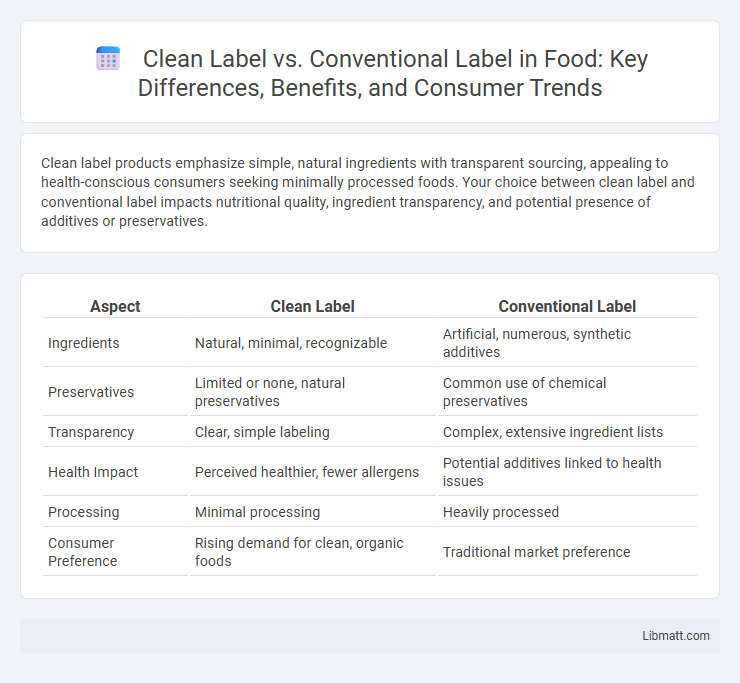Clean label products emphasize simple, natural ingredients with transparent sourcing, appealing to health-conscious consumers seeking minimally processed foods. Your choice between clean label and conventional label impacts nutritional quality, ingredient transparency, and potential presence of additives or preservatives.
Table of Comparison
| Aspect | Clean Label | Conventional Label |
|---|---|---|
| Ingredients | Natural, minimal, recognizable | Artificial, numerous, synthetic additives |
| Preservatives | Limited or none, natural preservatives | Common use of chemical preservatives |
| Transparency | Clear, simple labeling | Complex, extensive ingredient lists |
| Health Impact | Perceived healthier, fewer allergens | Potential additives linked to health issues |
| Processing | Minimal processing | Heavily processed |
| Consumer Preference | Rising demand for clean, organic foods | Traditional market preference |
Understanding Clean Label: Definition and Principles
Clean Label refers to food products made with simple, natural ingredients free from artificial additives, preservatives, and synthetic chemicals, emphasizing transparency and minimal processing. The principles focus on recognizable ingredients listed clearly on packaging, promoting consumer trust and health consciousness. Understanding Clean Label helps you make informed choices by prioritizing purity, sustainability, and ingredient integrity over conventional label products.
Conventional Labels: Traditional Food Ingredient Standards
Conventional labels adhere to traditional food ingredient standards, often including preservatives, artificial colors, and flavor enhancers to ensure product stability and shelf life. These labels typically list ingredients using scientific or chemical names, which may be less recognizable to consumers seeking natural or minimally processed foods. Understanding conventional labels helps you make informed choices based on ingredient transparency and food processing methods.
Key Differences Between Clean Label and Conventional Label
Clean Label products emphasize transparency, using simple, recognizable ingredients free from artificial additives and preservatives, whereas Conventional Label items often contain synthetic chemicals, preservatives, and complex ingredient lists. Clean Label prioritizes natural, minimally processed components that align with consumer demand for health and sustainability, while Conventional Label focuses on extended shelf life and cost-efficiency, sometimes compromising ingredient simplicity. Regulatory standards for Clean Label are less defined, relying heavily on consumer perception, unlike the more strictly regulated Conventional Label requirements for ingredient disclosure and safety compliance.
Consumer Perceptions and Trust in Labeling
Consumers increasingly trust clean labels over conventional labels due to the transparency and simplicity of ingredient lists that clean label products offer, often perceiving them as healthier and safer. Clean labels featuring natural, recognizable ingredients enhance consumer confidence and foster brand loyalty more effectively than conventional labels filled with artificial additives and complex terminology. Surveys indicate a growing preference for clean labels, with over 70% of shoppers willing to pay a premium for products they perceive as clean and trustworthy.
Ingredient Transparency: Clean Label vs Traditional Methods
Ingredient transparency in clean label products emphasizes natural, recognizable components with minimal processing, while conventional labels often include synthetic additives and preservatives that are less disclosed. Clean label standards prioritize clarity and simplicity on packaging, enabling consumers to identify each ingredient easily and assess its origin and safety. Traditional labeling may list chemical names and proprietary blends, which obscure detailed information and reduce consumer trust.
Health and Wellness Trends Driving Clean Label Demand
Health and wellness trends have significantly boosted the demand for clean label products, with consumers seeking transparency and natural ingredients free from artificial additives or preservatives. Studies show a growing preference for organic, non-GMO, and allergen-free products that align with clean label criteria, driven by increased health consciousness and dietary restrictions. Market data predicts that the global clean label market will surpass $47 billion by 2027, reflecting strong consumer demand for healthier, minimally processed food options compared to conventional labels.
Regulatory Requirements for Clean and Conventional Labeling
Regulatory requirements for clean label products emphasize transparency, requiring clear ingredient declarations and avoidance of artificial additives, preservatives, and synthetic chemicals, aligning with consumer demand for natural and minimally processed foods. Conventional labeling follows established regulations that permit the inclusion of approved additives and preservatives, focusing on accurate nutritional information and safety compliance as dictated by agencies like the FDA or EFSA. Compliance with specific labeling laws such as the U.S. Food Safety Modernization Act (FSMA) or the European Union's Food Information to Consumers (FIC) Regulation ensures that both clean and conventional labels provide truthful and non-misleading information to consumers.
Impact on Product Formulation and Manufacturing
Clean Label products prioritize natural, minimal ingredients, leading to simpler formulations that often exclude artificial additives, preservatives, and synthetic chemicals, which can challenge shelf life and texture stability. Conventional Label products utilize a broader array of synthetic ingredients and additives, enabling manufacturers to optimize consistency, shelf life, and production efficiency with more complex formulations. This difference forces clean label manufacturing to innovate alternative preservation and processing techniques while balancing consumer demand for transparency and product quality.
Market Growth and Industry Adoption of Clean Label Products
Clean label products have experienced significant market growth, driven by increasing consumer demand for transparency, natural ingredients, and minimal processing. The clean label industry adoption rate has accelerated among major food manufacturers, who are reformulating products to replace artificial additives with simpler, recognizable ingredients. Your opportunity lies in capitalizing on this trend by aligning product development with clean label standards, which can enhance brand trust and meet evolving consumer preferences.
Future Outlook: The Evolution of Food Labeling Practices
Clean Label trends promise a future where transparency and simplicity dominate food labeling practices, meeting consumers' growing demand for natural ingredients and minimal processing. Conventional Labeling, while still prevalent, is evolving to incorporate clearer ingredient disclosures and sustainability claims to remain competitive. Your ability to choose products with well-defined, honest labels will shape market standards and drive further innovation in food transparency.
Clean Label vs Conventional Label Infographic

 libmatt.com
libmatt.com